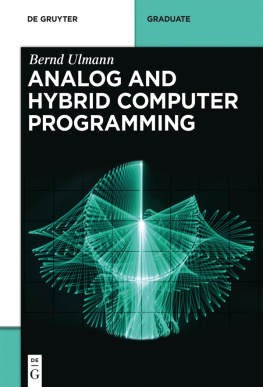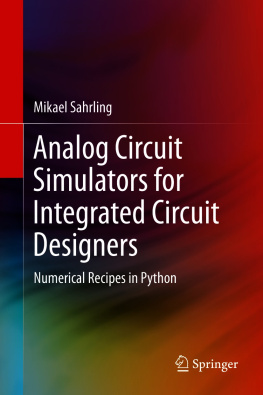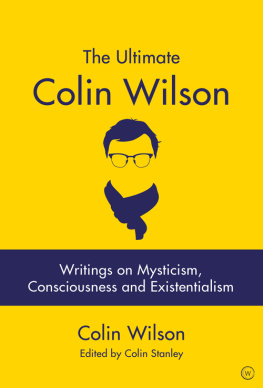Ray Wilson - Make: Analog Synthesizers
Here you can read online Ray Wilson - Make: Analog Synthesizers full text of the book (entire story) in english for free. Download pdf and epub, get meaning, cover and reviews about this ebook. year: 2013, publisher: Maker Media, Inc, genre: Home and family. Description of the work, (preface) as well as reviews are available. Best literature library LitArk.com created for fans of good reading and offers a wide selection of genres:
Romance novel
Science fiction
Adventure
Detective
Science
History
Home and family
Prose
Art
Politics
Computer
Non-fiction
Religion
Business
Children
Humor
Choose a favorite category and find really read worthwhile books. Enjoy immersion in the world of imagination, feel the emotions of the characters or learn something new for yourself, make an fascinating discovery.
- Book:Make: Analog Synthesizers
- Author:
- Publisher:Maker Media, Inc
- Genre:
- Year:2013
- Rating:3 / 5
- Favourites:Add to favourites
- Your mark:
- 60
- 1
- 2
- 3
- 4
- 5
Make: Analog Synthesizers: summary, description and annotation
We offer to read an annotation, description, summary or preface (depends on what the author of the book "Make: Analog Synthesizers" wrote himself). If you haven't found the necessary information about the book — write in the comments, we will try to find it.
Make: Analog Synthesizers — read online for free the complete book (whole text) full work
Below is the text of the book, divided by pages. System saving the place of the last page read, allows you to conveniently read the book "Make: Analog Synthesizers" online for free, without having to search again every time where you left off. Put a bookmark, and you can go to the page where you finished reading at any time.
Font size:
Interval:
Bookmark:
For Debra Lee, whose love and kindness sustain me; Jonathan and Arielle, the lights of my life; and my parents, Charles and Elia Wilson, who always encouraged me to be inventive.
I hope this book becomes tattered from use and is kept close at hand on your desk or work bench. Were going to cover a lot of information about analog synthesizers and how to get started in the fun and engaging hobby of synth-DIY . Youll need some electronics knowledge to fully benefit, but I think youll find whats here interesting and informative regardless of your experience. Be forewarned that this is one of those hobbies that can become consuming, with ideas building on other ideas and inspiration coming at all hours of the day and night. You may find yourself soldering in your skivvies from time to time because you come up with an idea that simply cant wait for tomorrow to try out.
Ive had a consuming interest in analog synthesizers since the first time I heard Switched-On Bach back in the spring of 1968. Back then, the only thing that separated me from one of those analog beauties was cash, and lots of it. Those early synthesizers were way out of my financial reach, as in thousands of dollars out of my reach. However, I had an excellent opportunity to at least check them out and play them. My window into the world of analog synthesizers was provided by a music store in McKees Rocks, Pennsylvania, that has been there since 1965.
I haunted the keyboard room at Hollowood Music and Sound just about every day of my adolescence, and I can still remember being able to try out any of the amazing units on display. Looking back, I really appreciate how cool Mr. Hollowood was for allowing a skinny kid with long, curly hair and a penchant for trying to imitate Keith Emerson (I said trying) to jam on any synth in the store while he was well aware that I couldnt possibly afford any of them (). The person who ran the keyboard room was an amazing keyboard player named John Bartel. John was one of my heroes because not only was he an outstanding keyboardist, but he actually knew how to get an awesome sound out of any synth in the place, including the ARP 2600.

In those days I didnt know an ADSR from the business end of my alimentary canal. Eventually, after I started to work at U.S. Steel (as in an actual steel mill), I had some money in my pocket, and you can probably guess where I spent it. I went through a litany of analog synthesizers, buying, selling, and trading mainly Korgs, Mini-Moogs, and a variety of the patchable semimodular Roland units. Im ashamed to say that often I didnt fully explore the nuances of a synth before trading it off for a newer, shinier one.
Analog synth greed got a hold on me, oh lordy it got a hold on me. Playing and recording with them on my Tascam 4-track with 10-inch reels was a blast, but I wanted something more. I wanted to be able to make an electronic device that would allow me to interact with the synthesizer somehow. I had grandiose visions of someday making my own synthesizer. Little did I know that one day I would be building my own modular analog synthesizers that could do anything any synthesizer in that keyboard room could do (and more). And you can too .
When my father, who was a remarkable mechanical engineer, used his influence to get me a job at the U.S. Steel Wheel & Axle Works in McKees Rocks, Pennsylvania, as a laborer in the labor gang, I couldnt have guessed what was in store. To this day it surprises me that the mill would eventually be my ticket to receiving electronics training and in time (OK a lot of time) lead to me starting my own small electronics business, Music From Outer Space LLC , which I run to this day.
After a year or so of shoveling, sweeping, and jackhammeringand way more than likely at the behest of my fatherI got into an electronic repairman apprenticeship program. This meant that I was freed from the labor gang! Not that jackhammering scale (the drossy crust that falls from steel billets as they are being heat-treated) out of furnaces that had been heat-treating train wheels the day before wasnt fun, but the apprenticeship was a godsend (well actually a dadsend ). The apprenticeship meant that I got to go to the Homestead Works in Homestead, Pennsylvania (where they used to produce those giant buckets full of molten steel) and get paid more than I did as a laborer to learn electronics!
I had found my passion. I supplemented my classroom training with breadboard experimentation, a Heathkit microprocessor trainer kit, and reading, reading, and then more reading. I did the practice math problems and experiments in the books, and Id encourage you to do the same if youre just getting started. Through it all I learned enough to spend the next 15 years in the medical electronics industry, finally landing in the biomedical engineering department of Siemens Pacesetter. Interestingly, I was able to do this without an engineering degree, but I think those days are over, so get in college and stay there until youre armed and dangerous with a degree in something useful.
Equipped with enough electronics training to be dangerous, a friend and I started a small electronics kit sideline called Waveform Processing . We were located in Crafton, Pennsylvania, and were in business from the late 1970s into the early 1980s. I designed some simple sound-making boxes (

To this day, I still cringe when I think of what we used to pay for a 15-word classified ad buried among hundreds of others in the back of that magazine: $500. Needless to say, the brand Waveform Processing is not rolling off of anybodys tongue today.
My interest in electronics didnt wane by any means; I kept on researching and breadboarding and developed some very cool mono- and polyphonic synths. I remember the excitement of discovering the Curtis Electromusic Specialties chips designed by Doug R. Curtis. They were simply the coolest chips ever. You could easily build voltage-controlled filters and voltage-controlled oscillators that tracked one volt per octave perfectly and were completely temperature compensated. I was in heaven. Eventually, however, family and job responsibilities caused me to pay less and less attention to synth-DIY.
I was getting my electronics design fix at Intec Systems in Blawnox, Pennsylvania, and eventually Siemens Pacesetter in Sylmar, California, so my focus shifted to designing electronic test equipment and writing software. In 1994, an earthquake of magnitude 6.7 chased us out of California and on to Aurora, Colorado. I can still remember throwing my first attempt at a modular into a huge dumpster as we hurriedly cleaned house and prepared to move. (Man I wish I still had that thing.)
After my work focus shifted entirely to software development, my need to work with electronics brought me full circle and back to synth-DIY with a vengeance. I started a website called Ray-Land (perhaps Im a tad bit narcissistic) and began to publish the circuits, PC layouts, and circuit descriptions I was coming up with. I developed a simple, battery-powered mini-synthesizer called the
Font size:
Interval:
Bookmark:
Similar books «Make: Analog Synthesizers»
Look at similar books to Make: Analog Synthesizers. We have selected literature similar in name and meaning in the hope of providing readers with more options to find new, interesting, not yet read works.
Discussion, reviews of the book Make: Analog Synthesizers and just readers' own opinions. Leave your comments, write what you think about the work, its meaning or the main characters. Specify what exactly you liked and what you didn't like, and why you think so.













